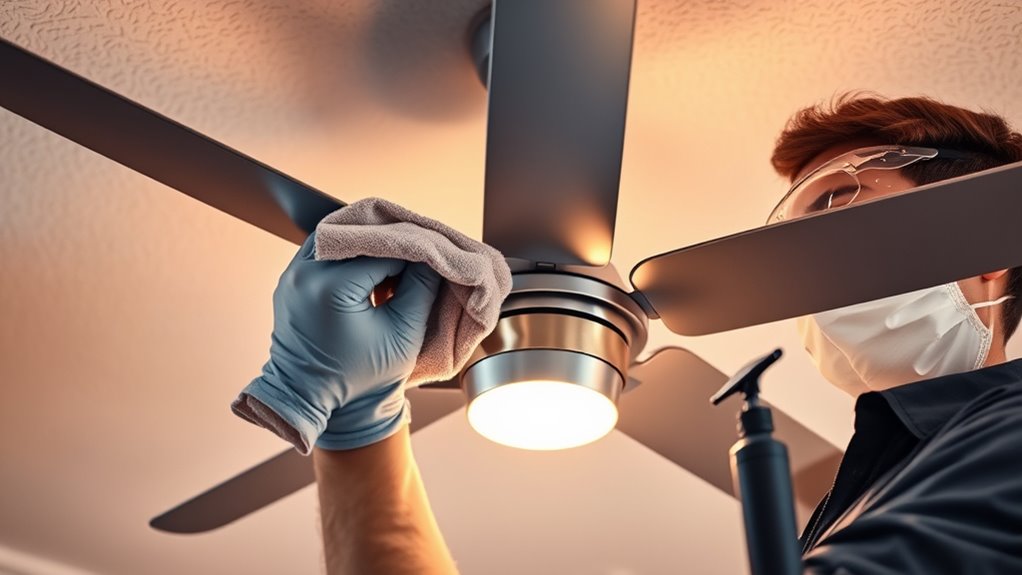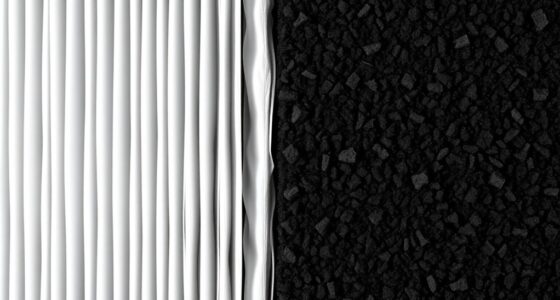To keep your ceiling fan running smoothly, regularly clean the blades with a microfiber cloth or gentle brush to remove dust and dirt, which can cause wobbling and noise. Lubricate the motor with a few drops of lightweight oil every six months to reduce friction and prevent squeaks. Always turn off the power before maintenance, and avoid over-oiling. Continuing with these steps will help you maintain peak performance and extend your fan’s lifespan.
Key Takeaways
- Regularly dust and clean fan blades with a microfiber cloth to prevent wobbling and maintain efficiency.
- Turn off and cool the fan before applying a small amount of high-quality motor oil to lubrication points.
- Use gentle cleaning solutions and avoid soaking blades to prevent damage and warping.
- Lubricate the motor periodically, typically every six months, to reduce noise and prolong lifespan.
- Always disconnect power before maintenance to ensure safety and perform routine upkeep as scheduled.

Have you ever wondered why your ceiling fan isn’t performing as smoothly as it used to? Over time, dust and dirt accumulate on the fan blades, which can cause wobbling, noise, and decreased efficiency. To keep your fan running quietly and effectively, regular fan blade dusting is essential. You can use a microfiber cloth or a gentle brush to remove the dust from each blade. For stubborn grime, slightly dampen the cloth with water or a mild cleaning solution, but avoid soaking the blades. Making sure your blades are clean reduces imbalance and noise, helping the fan operate more smoothly.
Once you’ve cleaned the blades, it’s equally important to consider the motor. The motor is the heart of your ceiling fan, and neglecting its lubrication can lead to squeaking, increased wear, and even motor failure over time. Applying motor oil is a simple yet effective way to maintain the motor’s performance. Before applying oil, turn off the fan and let it cool down. Check the manufacturer’s instructions to locate the lubrication points—most fans have designated oil ports or accessible bearings. Carefully add a few drops of high-quality, lightweight motor oil into these points. You don’t need much—just enough to coat the moving parts without over-application. Proper motor oil application reduces friction, minimizes noise, and prolongs the lifespan of the fan.
Lubricate your ceiling fan motor with a few drops of high-quality oil to reduce noise and extend lifespan.
Regular maintenance also helps prevent motor failure and extends the overall lifespan of your ceiling fan. Avoid the temptation to overlook these maintenance steps. Dusting the fan blades regularly not only keeps the fan looking clean but also ensures it spins freely without wobbling or making unnecessary noise. Meanwhile, lubricating the motor prevents rust and reduces mechanical strain. When you perform these tasks, you’re actively improving your fan’s performance and extending its lifespan. Remember, consistent maintenance doesn’t require a lot of time but offers significant benefits—quieter operation, less energy consumption, and fewer repairs down the line.
In addition to fan blade dusting and motor oil application, make sure to turn off the fan and disconnect it from power whenever you’re cleaning or lubricating. This safety step helps prevent accidents. Keep a routine schedule, perhaps every six months, depending on how often you use the fan and your environment’s dust levels. With these simple steps, you’ll enjoy a fan that runs smoothly, quietly, and efficiently, saving you money and frustration in the long run.
Frequently Asked Questions
How Often Should I Clean My Ceiling Fan?
You should clean your ceiling fan every 1 to 2 months to prevent dust accumulation and maintain efficient fan blade maintenance. Regular cleaning reduces dust buildup, which can impair airflow and cause allergies. Use a damp cloth or a dusting tool to wipe down the blades thoroughly. Keeping up with these routine cleanings guarantees your fan runs smoothly, looks great, and prolongs its lifespan by preventing dust-related issues.
Can I Use Household Cleaning Products on Ceiling Fans?
You shouldn’t use household chemicals or cleaning agents on your ceiling fan, as they can damage the finish or motor components. Instead, opt for a damp microfiber cloth or a gentle, non-abrasive cleaner specifically designed for electronics or painted surfaces. Avoid harsh chemicals like bleach or ammonia, which can cause discoloration or corrosion. Regular, careful cleaning will keep your fan looking good and working efficiently without risking damage.
What Type of Lubricant Is Best for Ceiling Fans?
The best lubricant for ceiling fans is a lightweight, 3-in-1 oil or silicone-based lubricant. You should avoid thick greases or WD-40, as they can attract dust. Use lubrication techniques like applying a small amount directly to the motor shaft or bearing. This guarantees smooth operation without over-lubricating, which can cause more issues. Keep your fan quietly spinning with the right type of lubricant and proper lubrication techniques.
How Do I Access the Fan’s Motor for Lubrication?
To access the fan’s motor for lubrication, first turn off the power and remove the ceiling fan’s canopy to expose the motor housing. Locate the lubrication points, usually small oil ports or bearings. Use a suitable lubricant, like light machine oil, and apply it carefully to these points. Gently spin the fan blades to evenly distribute the lubricant, ensuring smooth operation and preventing squeaks or roughness.
Are There Safety Precautions for Cleaning Ceiling Fans?
Yes, you should take safety precautions when cleaning ceiling fans. Turn off the power at the circuit breaker to prevent electrical hazards. Use appropriate cleaning tools like a microfiber cloth or a duster to avoid damage. Avoid using water or harsh chemicals near electrical components. Always make certain the fan blades are completely stopped before cleaning, and wear gloves if necessary, to protect yourself during the process.
Conclusion
Now that you’ve cleaned and lubricated your ceiling fan, imagine it spinning smoothly like a gentle breeze on a warm day. With each turn, it quietly hums, free of dust and squeaks, bringing fresh air and comfort to your space. Regular maintenance keeps it performing at its best, transforming your room into a cool, inviting haven. So, keep up the care, and enjoy the effortless, whisper-quiet breeze your fan provides for years to come.









